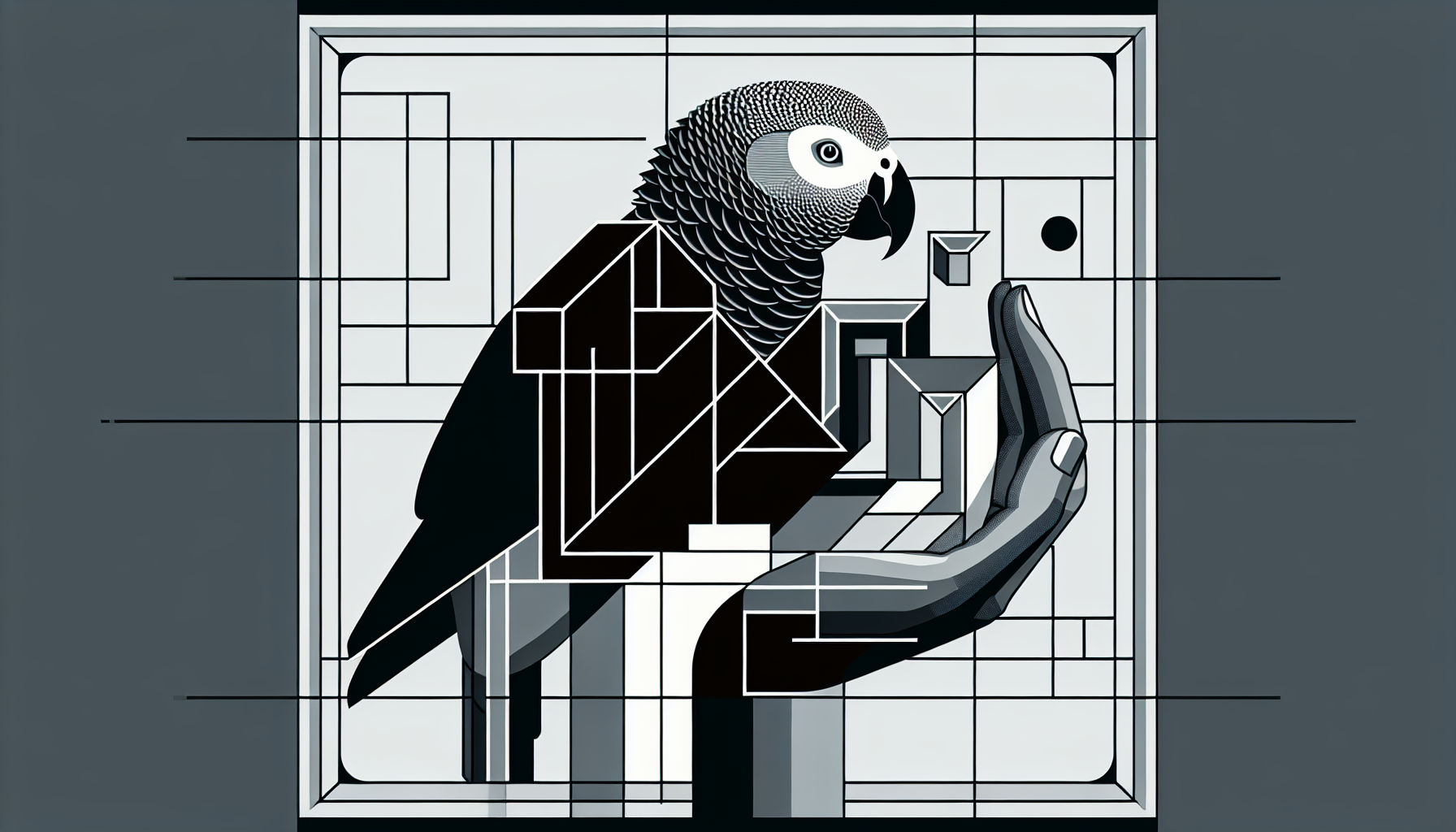Table of Contents
African Grey Parrot Care
Daily Grooming Routine
Taking care of your African Grey Parrot means maintaining a daily grooming routine to keep them healthy and happy. These smart birds love to groom themselves, often cleaning their feathers and spreading a special dust called “powder down feathers” all over their plumage (Psittacus).
Here’s how you can help:
- Feather Maintenance: While African Greys are pretty good at grooming their feathers, you can help by gently stroking their feathers in the direction they grow. This helps get rid of loose feathers and keeps their plumage looking sharp.
- Beak Care: Give them cuttlebone or wooden toys to help wear down their beak naturally. For more tips, check out our parrot beak care section.
- Nail Trimming: Keep an eye on their nails and trim them if they get too long. Overgrown nails can be uncomfortable for your bird.
- Eye and Ear Cleaning: Use a damp cloth to gently wipe around their eyes and ears, making sure there’s no dust or debris.
Bathing Tips and Frequency
Even though African Grey Parrots prefer dry grooming, they do benefit from the occasional bath, especially when it’s warm out. Bathing helps remove dust and keeps their feathers in good shape.
Bathing Tips:
- Use Lukewarm Water: Make sure the water is just right—not too hot or too cold.
- Gentle Spraying: Use a spray bottle to mist their feathers gently. The spray should be fine and not too strong.
- Avoid Soaking: African Greys don’t like being soaked. A light misting is usually enough.
- Supervised Bath Time: Always keep an eye on your parrot during bath time to make sure they’re safe and comfortable.
- Drying Off: Let them dry naturally in a warm spot. Avoid using a hairdryer as the noise and heat can stress them out.
Bathing Frequency:
How often you bathe your parrot can depend on their preference and the weather. Here’s a general guideline:
| Season | Frequency |
|---|---|
| Winter | Once every 2-3 weeks |
| Summer | Once a week |
For more detailed feather care tips, visit our parrot feather care section.
By sticking to these grooming and bathing tips, you can keep your African Grey Parrot healthy, happy, and looking their best. For more parrot care advice, check out our parrot care 101 guide.
Feeding Your African Grey Parrot Right
Want to keep your African Grey Parrot happy and healthy? It all starts with the right diet. Let’s break down what your feathered friend needs to thrive.
The Basics: Pelleted Food
Most of your parrot’s diet should come from pelleted food—think of it as their main course. Experts say 60-80% of their daily intake should be from these pellets. These pellets are packed with essential nutrients to keep your bird in top shape.
Here are two top picks:
- Kaytee Exact Rainbow Parrot: Packed with Omega-3, this food helps with better feathering and brighter colors.
- Pretty Bird African Grey Special: Tailored for African species, it includes extra calcium for overall fitness.
| Pelleted Food Brand | Key Benefits |
|---|---|
| Kaytee Exact Rainbow Parrot | Omega-3, better feathering, brighter colors |
| Pretty Bird African Grey Special | Extra calcium, tailored for African species |
Adding Some Flavor: Veggies, Fruits, and Nuts
Pellets are great, but variety is the spice of life. Mix in some fresh veggies, fruits, and nuts to keep your parrot’s diet balanced and interesting.
Veggies
Fresh veggies are a must. African Greys love:
- Broccoli
- Brussel sprouts
- Kale
- Spinach
Just remember to remove any uneaten veggies after a couple of hours to avoid spoilage.
Fruits
Fruits are like nature’s candy, full of vitamins. Offer them cut up in a bowl or on a fruit skewer. Dried fruits work too, but always remove leftovers after a few hours.
Nuts and Seeds
Nuts and seeds are great for variety and enrichment. Use them as occasional treats, and make sure they’re unsalted and free from harmful additives.
| Food Type | Examples |
|---|---|
| Vegetables | Broccoli, Brussel sprouts, Kale, Spinach |
| Fruits | Apples, Bananas, Berries, Grapes |
| Nuts and Seeds | Almonds, Walnuts, Sunflower seeds, Pumpkin seeds |
Keep It Balanced
A balanced diet for your African Grey Parrot means combining pelleted food with fresh veggies, fruits, and nuts. This mix helps them live a healthy, vibrant life. For more tips on parrot care, check out our guides on parrot beak care and parrot feather care.
So, what are you waiting for? Give your parrot the diet they deserve and watch them thrive!
Getting to Know Your African Grey Parrot
African Grey Parrots are not just birds; they’re feathered geniuses with quirky personalities. Understanding their behavior and communication can help us give them the best care possible.
Social Butterflies with Big Brains
These parrots love to hang out in big groups at night and split into smaller squads during the day to munch on fruits, berries, nuts, and seeds high up in the trees. They rarely touch the ground, preferring the treetop life.
African Greys are brainiacs, often compared to four- to six-year-old kids in terms of smarts. They need lots of toys, puzzles, and attention to keep them happy and avoid boredom.
These birds are also romantics at heart. They form lifelong bonds with their mates and share the job of raising their chicks until they’re ready to fly at about ten weeks old (Maryland Zoo).
The Chatty Cathys of the Bird World
African Grey Parrots are famous for their vocal talents. They can squawk, whistle, shriek, scream, and mimic just about any sound they hear (Maryland Zoo). This isn’t just for show; it’s how they chat with their flock.
These parrots can understand colors, numbers, shapes, and even use words meaningfully. Their knack for mimicking human speech makes them fun companions, but it also means they need a lot of mental workouts.
To keep your African Grey entertained, mix up their toys, teach them new words, and spend time interacting with them. For tips on keeping their beaks and feathers in top shape, check out our articles on parrot beak care and parrot feather care.
By getting a handle on their social quirks and chatty nature, we can make sure our African Grey Parrots live their best lives. For more tips on caring for different parrot species, visit our guides on macaw parrot care, quaker parrot care, and ringneck parrot care.
Keeping Your African Grey Parrot Healthy
Taking care of your African Grey parrot means staying ahead of common health issues. Two big ones to watch out for are hypocalcaemia and Psittacine Beak and Feather Disease (PBFD).
Hypocalcaemia: The Calcium Crisis
Hypocalcaemia, or low calcium, is a major problem for African Grey parrots. It hits about 95% of these birds, leading to scary symptoms like falling off their perch or having seizures. Quick action with calcium therapy is key to getting them back on their feet.
| Symptom | How Often It Happens |
|---|---|
| Falling from Perch | 95% |
| Having a Fit | 95% |
To keep hypocalcaemia at bay, feed your parrot a diet packed with calcium. Think cuttlebones, calcium-rich veggies, and special supplements. Regular vet check-ups can help keep an eye on their calcium levels and overall health.
Psittacine Beak and Feather Disease: The Feather Foe
PBFD, caused by the Circovirus, mainly targets young birds, messing with their feather and beak growth. It weakens their immune system, leading to serious feather loss and beak issues. In budgies, this disease is called French Moult, which can leave them with damaged feathers and unable to fly.
| Disease | Affected Area | Budgie Name |
|---|---|---|
| PBFD | Feather and Beak Tissue | French Moult |
To prevent PBFD, keep your parrot’s environment clean and stress-free, avoid contact with infected birds, and provide a balanced diet. Regular vet visits are crucial for early detection and management.
For more tips on parrot care, check out our articles on parrot beak care and parrot feather care. Want to know more about caring for baby parrots or macaws? We’ve got you covered with baby parrot care and macaw parrot care. Keep your feathered friend happy and healthy!

